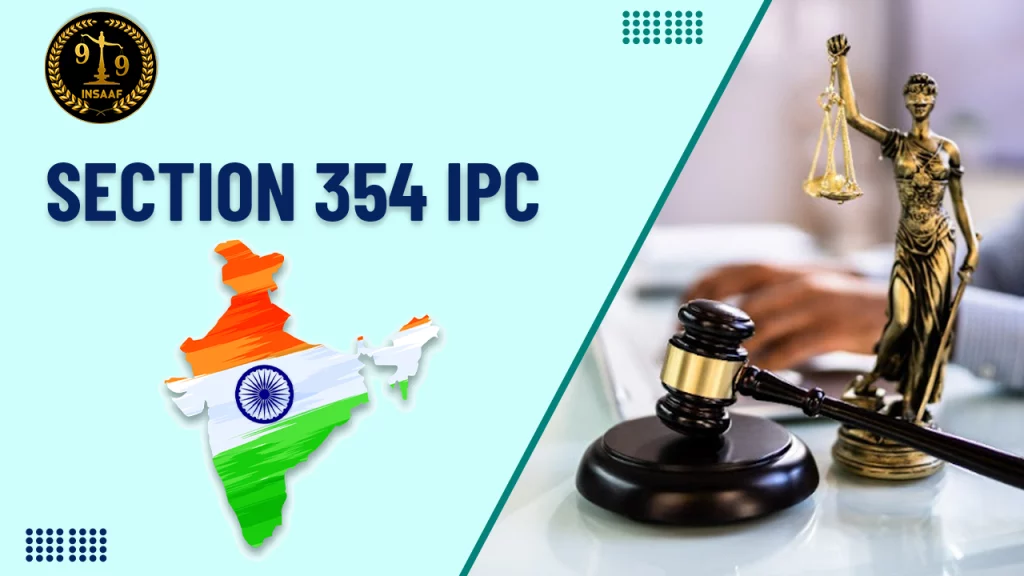

Online Legal Advice from Insaaf99® Online Lawyer Consultation in India


Online Legal Advice from Insaaf99® Online Lawyer Consultation in India

Section 354 of the Indian Penal Code (IPC) covers "Assault or criminal force to woman with intent to outrage her modesty." This section covers obscene acts against women to violate their dignity and modesty. This section's violations violate women's dignity and autonomy.
Section 354 IPC protects women's rights. It protects women from offenses that threaten their safety and respect. Criminalizing such acts deters perpetrators and makes women safer.
Legal Literacy: Grasping sanctions educates people about offense seriousness and consequences, promoting legal literacy and recognizing illegal acts.
Prevention: Knowledge of penalties deters potential offenders, curbing unlawful behavior.
Victim Empowerment: Comprehending punishment aids victims in exploring legal options, empowering them for informed decisions.
Balancing Rights: Recognizing bailable safeguards against accused rights and victim protection, averting wrongful detention or bail refusal.
Curbing Abuse: Awareness of bailable and non-bailable offenses prevents unjustified detention, reducing legal process misuse.
Legal Advocacy: Lawyers guide victims and defendants better with knowledge of punishment and bail options, enhancing representation.
Policy Impact: Well-informed citizens drive policy changes by leveraging legal understanding, and enhancing law effectiveness.
The section 354 of the Indian Penal Code, which addresses the offenses of assaulting or using criminal force against women with the intent to outrage their modesty, includes a punishment structure that reflects the gravity of the offenses. Depending on the gravity of the transgression, this framework imposes varying degrees of punishment, including imprisonment and fines.
Age of the Victim: The age of the victim is a significant factor in determining the punishment, with harsher penalties for crimes committed against juveniles.
Intention: deliberate and malevolent acts result in harsher punishments, taking into account the offender's state of mind.
Potential Harm: Courts take into account the harm inflicted or intended, ensuring that the punishment fits the offense's impact.
The framework seeks a delicate balance between justice for victims and respect for the rights of the accused. It seeks to prevent excessive punishments and maintain a proportional relationship between the offense and the repercussions.

Behind Bars or Beyond Bail: An important question emerges, whether or not 354 ipc bailable or not offenses are considered bailable. What happens next could have serious consequences for the accused's freedom during the trial.
Bailable or Non-Bailable A fundamental question arises are these offenses subject to bail? This inquiry casts a shadow over the accused's liberty as legal proceedings unfold.
Legal Criteria and Reflective Thoughts: Determining the outcome of a bond requires analyzing numerous factors. The nature of the crime, the likelihood of flight, the potential for damage to the victim or society, prior convictions, and the quality of the evidence all interact in a complex dance.
A tightrope walk transpires between the accused's freedom and the need to protect victims and society, illuminating the complexity of bail decisions in Section 354 IPC cases.
Understanding the parole complexities of IPC section 354 is crucial. It highlights the delicate balance between individual rights and collective welfare, highlighting the role of the legal system in upholding justice, fairness, and safety for all parties involved.
Navigating Bail Criteria: Understanding the criteria courts consider when setting bail is crucial.
The Gravity of Offense: Courts carefully assess the offense's gravity. The alleged act's weight determines bail.
Potential Threat to the Victim: Courts consider the future harm a released defendant may do. Safety comes first.
Criminal History: The past echoes. The accused's criminal past influences the decision. A criminal history can affect bail.
Harmonizing the Scales: The judicial system walks the tightrope. All parties are protected by weighing each factor.
Understanding the intricacies of these factors reveals bail considerations. The legal system's quest for fairness dances between individual rights and communal well-being.
Legal Path: The legal proceedings that follow an offense under Section 354 of the Indian Penal Code can be learned through an investigation of its aftermath.
Protection for Both Parties: Both the accused and the victim are afforded a wide range of protections throughout the legal process to ensure fairness.
Protection for the Accused: The right to a fair trial, due process, and the right to a lawyer ensures that the accused will not be mistreated.
Victims' Rights: Victims have rights that give them a voice in the legal process, including the right to be heard, protection from intimidation, and access to justice.
This equilibrium is maintained and the rights of the accused and the victim are respected because of these safeguards, which form the foundation of a fair legal system.
It is essential to empower through education and proactive prevention of violations of Section 354 of the IPC. The provision of knowledge to law enforcement ensures prompt action and justice. Safe reporting locations and community involvement enhance prevention efforts. By promoting awareness and employing proactive strategies, society can condemn and deter such crimes, thereby making the environment safer for all.
Legal literacy promotes fairness and Section 354 IPC implementation. It helps people understand crimes, prevention, and the law. Awareness empowers victims, lawyers, and policymakers. Legal literacy links comprehending Section 354 IPC to its proper application, making society safer and fairer.
Insaaf99, an innovative online Legal consultation firm, plays a pivotal role in aiding individuals dealing with cases under IPC Section 354. This platform provides expert legal advice, guidance, and support tailored to the unique nuances of such cases.
By connecting people in need with attorneys, Insaaf99 encourages people to take charge of their own legal matters, stand up for their rights, and be an active part of the legal process. By providing easy access to knowledgeable professionals, this platform helps bring IPC 354 cases to a fair and just conclusion, laying the groundwork for a society where law and order thrive.
Also Read